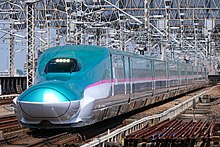This article needs additional citations for verification. (July 2009) |

Transport in Japan is modern and highly developed. Japan's transport sector stands out for its energy efficiency: it uses less energy per person compared to other countries, thanks to a high share of rail transport and low overall travel distances.[1] Transport in Japan is also very expensive in international comparison, reflecting high tolls and taxes, particularly on automobile transport.[2] Japan's spending on roads has been large.[3] The 1,200,000 kilometres (750,000 mi) of paved road are the main means of transport.[4] Traffic in Japan drives on the left. A single network of high-speed, divided, limited-access toll roads connects major cities, which are operated by toll-collecting enterprises.
Dozens of Japanese railway companies compete in regional and local passenger transport markets; for instance, seven JR Group companies, Kintetsu Railway, Seibu Railway, and Keio Corporation. Often, strategies of these enterprises contain real estate or department stores next to stations. Some 250 high-speed Shinkansen trains connect major cities. All trains are known for punctuality.
There are 176 airports,[5] and the largest domestic airport, Haneda Airport, was by passenger traffic the third-busiest in Asia and the fourth-busiest in the world in 2018, but not in the top ten in 2022. The largest international gateways are Narita International Airport (Tokyo area), Kansai International Airport (Osaka/Kobe/Kyoto area), and Chūbu Centrair International Airport (Nagoya area). The largest ports include Nagoya Port.
- ^ Lipscy Phillip Y., Schipper Lee (2013). "Energy efficiency in the Japanese transport secto". Energy Policy. 56: 248–258. doi:10.1016/j.enpol.2012.12.045.
- ^ Lipscy Phillip Y (2012). "A Casualty of Political Transformation? The Politics of Japanese Energy Efficiency in the Transportation Sector" (PDF). Journal of East Asian Studies. 12: 3. doi:10.1017/S1598240800008080. Archived from the original (PDF) on 2 May 2019.
- ^ Japan's Road to Deep Deficit Is Paved With Public Works Archived 4 February 2009 at the Wayback Machine, New York Times in 1997
- ^ Chapter 9 Transport Archived 27 April 2011 at the Wayback Machine, Statistical Handbook of Japan
- ^ [1] Archived 5 January 2021 at the Wayback Machine The CIA World Factbook